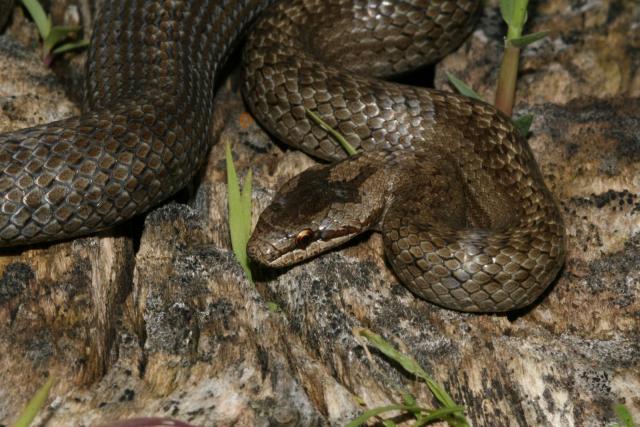Scientific classification:
Kingdom: Animalia
Phylum: Chordata
Subphylum: Vertebrata
Class: Reptilia
Order: Squamata
Suborder: Serpentes
Family: Colubridae
Coronella austriaca is a harmless colubrid species found in northern and central Europe, but also as far east as northern Iran. The EMBL currently recognizes three subspecies, including the typical form described here.
Both sexes grow to an average length of about 50 cm. Two specimens measuring 83 cm have Sweden, as well as one in Ukraine near Chernobyl that was 92 cm.
The head has a rostral scale that is at least as deep as it is wide, creating a triangular indentation between the internasals (rarely separating them). The top of the head is covered with 9 large plates. The nasal scale is often divided. There is 1 preoculars and 2 postoculars. The temporals number 2+2 or 2+3. There are 7 (rarely 8) upper labials, of which the 3rd and 4th or 4th and 5th border the eye.
Midbody there are 19 (rarely 17 or 21) rows of smooth dorsal scales. The ventrals number 150-164 in male4s and 162-200 in females. The anal scale is divided and the subcaudals paired. Males have 54-70 subcaudals and females 40-76.
The color pattern consists of a brown, gray of reddish ground color with two rows of small, rather indistinct dark spots running down the back towards the tail. In some cases, each pair of spots may be united towards the neck area, forming a series of cross-bars over the back. There is also a very indistinct series of dark spots running along each of the flanks. These four series of spots that run the length of the body overlay four parallel, rather shadowy stripes that also run down the back and flanks.
Dorsally, the head has a somewhat heart-shaped marking that resembles an inverted V posteriorly. This shape is where the name Coronella comes from, which means coronet (a small crown). A relatively thick dark stripe extends from the nostril along the side of the head to a little beyond the neck, only being interrupted by the eye. The upper labials are whitish, grayish-white or light brown, sometimes with darker spots. The tongue is reddish brown or dark red.
Found from the south of England through France and the Low Countries to northern Spain and Portugal, Germany, Norway and Sweden (as far north as 63° latitude), Latvia, Lithuania, Estonia, Switzerland, Austria, Italy and Sicily (but not in Corsica or Sardinia), the western Balkans and Greece, and European Russia as far north as 57° latitude. In Asia, it is found from Turkey to Azerbaijan, Georgia (country), Armenia and northern Iran
http://www.greenmania.eu/knowledge-base/endangeredspecies/rezsiklo-coronella-austriaca/
Alfred Edmund Brehm: Az állatok világa - Légrády testvérek (1905)
http://hu.wikipedia.org/wiki/R%C3%A9zsikl%C3%B3
http://www.khvsz.mme.hu/index.php?option=com_content&view=article&id=87%3Arezsiklo-coronella-austriaca&catid=49%3Ahazai-huellk&Itemid=90&lang=hu
